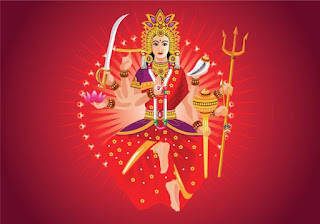Navratri--or the nine sacred days--mark the most auspicious days of the lunar calendar according to Hinduism. Celebrated with fervour and festivity all over north India, and every Hindu community the world over, these nine days are dedicated solely to Maa Durga (goddess Durga) and her nine avatars.
The prominent story associated with Navratri is the battle that took place between goddess Durga and the demon Mahishasura, who represents egotism. All the nine days of the festival are dedicated to each distinct avatar of the goddess; and each of these days has a significant colour attached to it, which devotees are expected to wear while taking part in the festivities. So, we've tried to break it down in easier terms for you:
The nine avatars of Durga and the colours of each avatar:
- Day 1: SHAILPUTRI: She is the embodiment of the collective power of Brahma, Vishnu and Mahesh. It is in this form that the goddess was worshipped as the consort of Shiva. The colour of the first day is red--it depicts action and vigour.
- Day 2: BRAHMCHARINI: The one who practices devout austerity. She is blissful and endows happiness, peace, prosperity and grace upon all devotees who worship her. Filled with bliss and happiness, she is the way to emancipation or moksha. The colour of the second day is royal blue, since it's synonymous with a calm-yet-powerful energy.
- Day 3: CHANDRAGHANTA: She represents beauty and grace and is worshipped on the third day for peace, tranquillity and prosperity in life. She is the apostle of bravery and possesses great strength. The colour of the day is yellow.
- Day 4: KUSHMUNDA: She is considered the creator of the universe. It is believed that Kushmunda created the universe through a bout of laughter and made it verdant with vegetation. Hence, the colour of the day is green.
- Day 5: SKAND MATA: She is the mother of Skanda, or Karthikeya, who was chosen by the gods as their commander-in-chief in the war against the demons. She is accompanied by Skanda in his infant form. The colour of the day is grey, as it indicates the vulnerability of a mother who can turn into a storm cloud when the need arises to protect her child.
- Day 6: KATYAYANI: Katyayani was born to the great sage, Kata, as an avatar of Durga. Dressed in orange, she exhibits immense courage. Hence, the colour of the day is orange.
- Day 7: KALRATRI: She has a dark complexion, dishevelled hair and a fearless posture. She has three eyes that shine bright, with flames emanating from her breath. She is black like the goddess Kali. She is the most fierce form of goddess Durga, and she is dressed in white, a colour that represents peace and prayer. Thus, the colour of the day is white.
- Day 8: MAHA GAURI: Maha Gauri is intelligent, peaceful and calm. It is said that due to her long austerities in the deep forests of the Himalayas, her colour transformed from white to back. However, later, when Shiva cleaned her with the waters of the Ganga, her body regained its beauty and she came to be known as Maha Gauri, which means extremely white. The colour of the day is pink, denoting hope and a fresh start.
- Day 9: SIDDHIDATRI: She has supernatural healing powers. She has four arms and is always in a happy state of mind. She blesses all gods, saints, yogis, tantriks and all devotees as a manifestation of the mother goddess. The goddess is shown to be in a blissful state, just like the sky on a clear day. Thus, the colour of the day is sky blue, representing wonderment about the beauty of nature.
Celebrated twice a year, the first Navratri that falls in the month of March or April is known as Chaitra Navratri. Most devotees of goddess Durga observe a fast for nine days, though some observe it for only two days. During the fast, one is meant to abstain from everyday grains like wheat, but can consume fruits, milk, tea, coffee, potatoes and one meal of sago food preparations--such as kuttu (singhada) atta and special rice. Instead of regular table salt, sendha (sea) salt is used for cooking.
Food eaten during Navratri:
- * Fried or boiled potatoes
- * Kadhi prepared with kuttu atta and sea salt
- * Aloo tikki
- * Banana chips
- * Makhane ki sabzi
- * Fruits and fruit juices
- * Sabudana kheer
- * Curd
- * Lassi
- * Kuttu atta roti with kaddu sabzi or aloo sabzi


Post a Comment